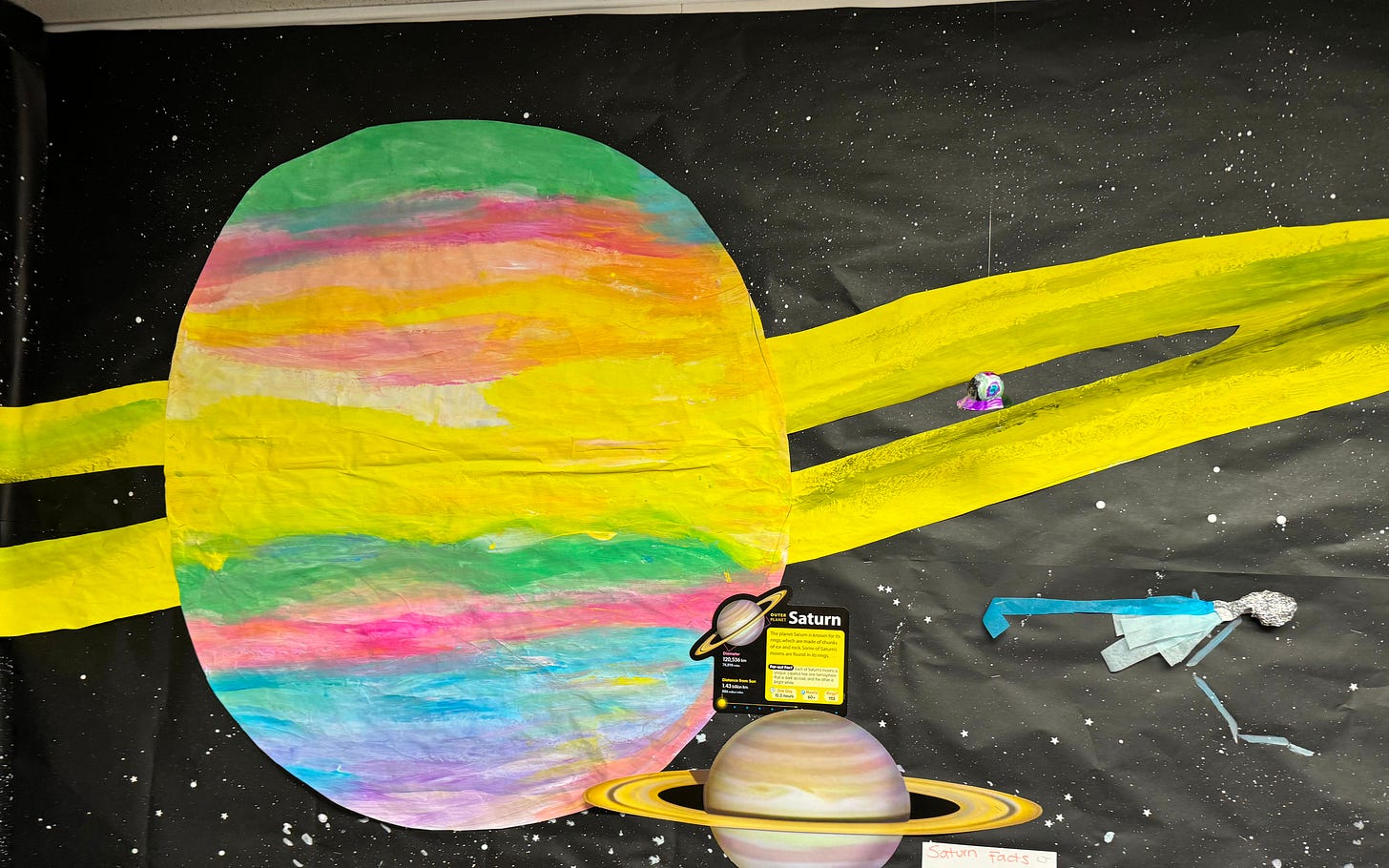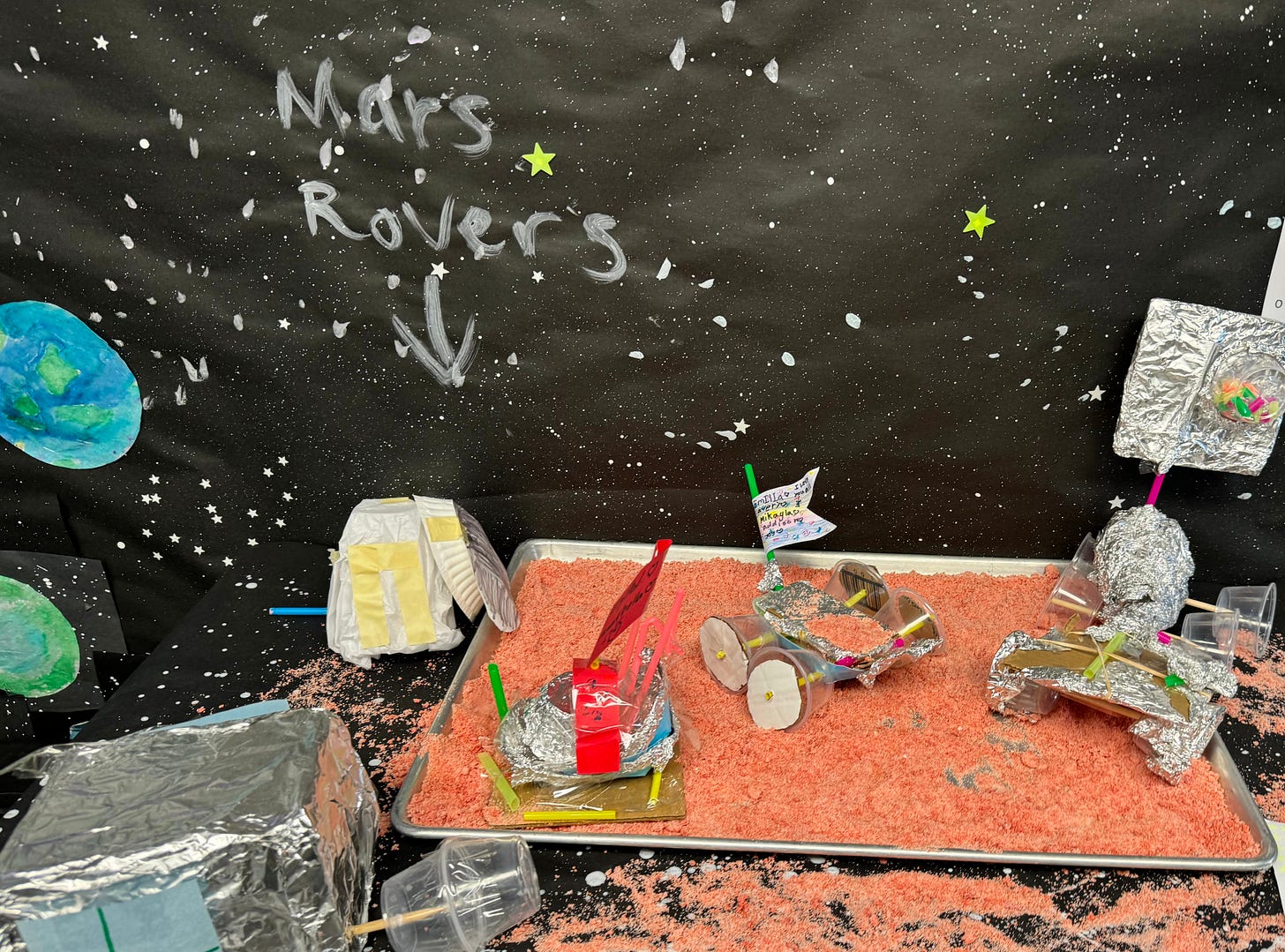Teaching at a Title 1 school comes with a lot of challenges—low test scores, limited resources, and a system that often prioritizes standardized testing over creativity. But I’ve always believed that project-based learning (PBL) isn’t a luxury—it’s a necessity.
When students learn through experience, something shifts. The lesson isn’t just words in a textbook; it becomes something real, something they can touch, build, and explore. But in schools like mine, where the focus is often on catching students up rather than pushing them forward, PBL gets pushed to the side.
That’s why I decided to shake things up. Instead of just talking about space, I turned my classroom into a galaxy of its own.
The Space Room Project: Bringing the Universe to the Classroom
I’ve always been obsessed with space—the vastness, the mystery, the way it makes you feel both tiny and limitless at the same time. I wanted my students to feel that, too. Not just hear about it, but experience it.
So, we got to work.
Over the course of two months, my students and I transformed a plain classroom into a full-blown space exhibit. They painted planets, built Mars rovers out of recycled materials, and carefully speckled stars across giant sheets of black paper. The walls turned into the solar system, the floor became the surface of Mars, and by the end, you couldn’t step inside without feeling like you were drifting into deep space.
I watched students who normally struggled with focus get completely lost in the process—mixing paint, measuring planet sizes, debating which moons to include. Older students helped younger ones, guiding them through each step. Kids who weren’t even in my program would peek in and ask, “Can I help?”
And then came the big moment—the day the Space Room opened.
Class after class came in, eyes wide, whispering "whoa" under their breath. They took their seats on star-shaped stickers as I placed glow-in-the-dark stars on their hands. The instrumental version of A Sky Full of Stars played softly in the background.
Then, I guided them through a “Star Dance.” Their hands became rising stars, twinkling stars, falling stars, and finally imploding supernovas. In those few minutes, they weren’t just students in a classroom—they were part of something bigger.
Then, I asked one student to take a pinch of salt from our Mars corner and blow it into the air.
"Can you see it?"
They squinted, searching. "No."
I smiled. "That’s Earth compared to the universe."
Next, I played a video zooming out from Earth, past the planets, past the farthest reaches of our solar system. As the screen faded to black, I asked:
"Can you still see Earth?"
Heads shook. Earth—our home, everything we know—was just a tiny speck in the vastness of space.
That was the moment. The moment I saw it click.
Some students sat in silence, completely lost in thought. Some whispered, “That’s crazy.” A few asked questions—deep, thoughtful ones—about space, about black holes, about what else is out there.
And that’s when I knew—this is what learning should feel like.
Why This Matters
This wasn’t just about space. It was about curiosity. It was about giving students a chance to wonder, to ask questions, to see themselves as part of something bigger.
And here’s the thing—PBL isn’t just “fun.” It works.
Research shows that students involved in hands-on space education projects see a 25% boost in critical thinking skills and score higher in science and math.
Schools that integrate project-based learning see higher engagement and better academic outcomes—especially in underserved communities.
Studies have found that when students learn about the vastness of space and the “Overview Effect” (the way astronauts see Earth from space), they show increased empathy and a stronger sense of global citizenship.
But beyond the numbers, I saw it firsthand. Students who normally sit in the back and barely participate were suddenly leading conversations. A Kindergartener student, usually quiet, couldn’t stop talking about Saturn’s rings. Sixth graders—too cool for everything—stuck around after the exhibit to ask more questions.
These kids, many of whom never saw themselves as "science kids," suddenly felt like scientists.
The reality is, project-based learning shouldn’t be a rare thing. It should be part of every classroom, in every school. But in places like Title 1 schools, where resources are stretched thin, PBL is often seen as an extra instead of an essential.
But what if we changed that?
What if we made space for more hands-on learning, more creativity, more opportunities for students to experience learning instead of just memorizing it?
The success of the Space Room Project showed me that it’s not just possible—it’s necessary. And while I pieced this project together on my own time, imagine what could happen if more schools had the funding, the flexibility, and the support to make PBL a priority.
What if more classrooms could be turned into space stations, rainforest ecosystems, or historical time machines?
What if we stopped thinking of project-based learning as a “nice-to-have” and started seeing it as what it really is—one of the most powerful ways to teach?
One Final Thought
As my students left the Space Room, I gave them one last message:
"Never stop reaching for the stars. Even if they seem just out of reach, you’ll still go further than if you never tried at all."
Because who knows? Maybe in 30 years, one of my students will be studying space, working at NASA, or engineering the next big discovery.
And maybe—just maybe—this was the moment their spark was ignited.




I did a similar thing teaching English and communication majors in a tech school—and it works.
“Research shows that students involved in hands-on space education projects see a 25% boost in critical thinking skills and score higher in science and math” — this is a flabbergasting statistic.